
The true finches are small to medium-sized passerine birds in the family Fringillidae. Finches generally have stout conical bills adapted for eating seeds and nuts and often have colourful plumage. They occupy a great range of habitats where they are usually resident and do not migrate. They have a worldwide native distribution except for Australia and the polar regions. The family Fringillidae contains more than two hundred species divided into fifty genera. It includes the canaries, siskins, redpolls, serins, grosbeaks and euphonias, as well as the morphologically divergent Hawaiian honeycreepers.

Serinus is a genus of small birds in the finch family Fringillidae found in West Asia, Europe and Africa. The birds usually have some yellow in their plumage. The genus was introduced in 1816 by the German naturalist Carl Ludwig Koch. Its name is Neo-Latin for "canary-yellow".

The genus Carduelis is a group of birds in the finch family Fringillidae.
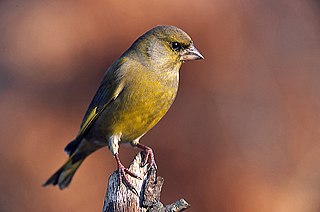
The European greenfinch or simply the greenfinch is a small passerine bird in the finch family Fringillidae.

The redpolls are a group of small passerine birds in the finch family Fringillidae, which have characteristic red markings on their heads. They are placed in the genus Acanthis. The genus name Acanthis is from the Ancient Greek akanthis, a name for a small now unidentifiable bird.

The common redpoll or mealy redpoll is a species of bird in the finch family. It breeds somewhat further south than the Arctic redpoll, also in habitats with thickets or shrubs.
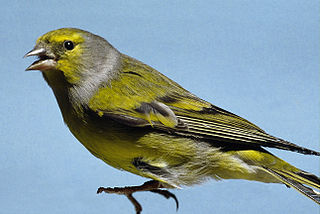
The citril finch, also known as the Alpine citril finch, is a small songbird, a member of the true finch family, Fringillidae.

The grey-capped greenfinch or Oriental greenfinch is a small passerine bird in the finch family Fringillidae that breeds in broadleaf and conifer woodlands of the East Palearctic.

The oriole finch is a small passerine bird in the finch family. It is found in Africa and is native to Burundi, Cameroon, Democratic Republic of the Congo, Equatorial Guinea, Kenya, Malawi, Nigeria, Rwanda, South Sudan, Tanzania and Uganda. It lives in subtropical or tropical moist evergreen montane forests.
The Lâm Viên Plateau is a plateau in southeastern Vietnam. At its centre is the city of Da Lat. Several mountains in this area rise to over 2,000 m (6,562 ft), the highest being Chư Yang Sin Summit at 2,442 m (8,012 ft).

The genus Rhynchostruthus is a small group of finches in the family Fringillinae. Commonly known as golden-winged grosbeaks, they are attractive, chunky, medium-sized, robust-billed songbirds restricted to the southern Arabian and northern Somalian regions.
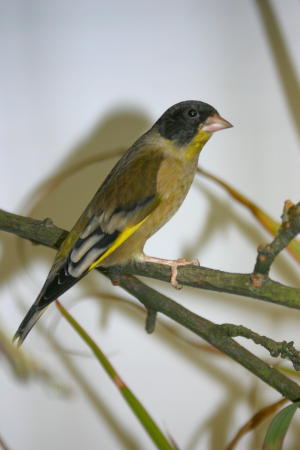
The black-headed greenfinch is a small passerine bird in the family Fringillidae. It is found in the Chinese province of Yunnan, northern Laos, eastern Myanmar and adjacent areas of Vietnam, Thailand and Northeast India. Its natural habitats are subtropical or tropical dry forest and subtropical or tropical dry shrubland.
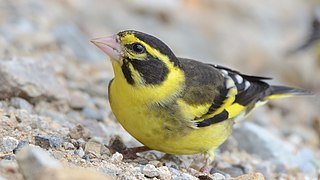
The yellow-breasted greenfinch is a small passerine bird in the family Fringillidae that is native to the northern regions of the Indian subcontinent.

The Indonesian serin is a species of finch in the family Fringillidae.
The Kipengere seedeater, also known as the Tanzania seedeater, is a species of finch in the family Fringillidae. It is found only in Tanzania specifically in Mbeya Region and Njombe Region. Its natural habitats are subtropical or tropical moist montane forest and subtropical or tropical high-elevation shrubland. It is threatened by habitat loss.

The greenfinches are small passerine birds in the genus Chloris in the subfamily Carduelinae within the Fringillidae. The species have a Eurasian distribution except for the European greenfinch, which also occurs in North Africa.

The slender-billed greenfinch("Carduelis" aurelioi) is an extinct songbird in the finch family Fringillidae. It was endemic to the island Tenerife in the Canary Islands, and became extinct after human settlement of the islands.

Spinus is a genus of passerine birds in the finch family. It contains the North and South American siskins and goldfinches, as well as two Old World species.

Linaria is a genus of small passerine birds in the finch family (Fringillidae) that contains the twite and the linnets. The genus name linaria is the Latin for a linen-weaver, from linum, "flax".
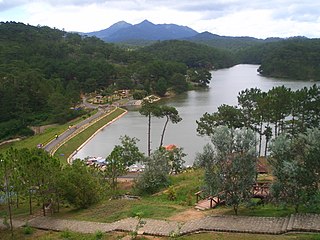
The Southern Annamites montane rain forests ecoregion covers a region of high biodiversity in the central and southern mountains of the Annamite Range in Vietnam. Terrain ranges from wet lowland forest to evergreen hardwood and conifer montane rain forest. There is a short dry season centered on January–February, but fog and dew are common throughout the year and support a lush forest character.



















